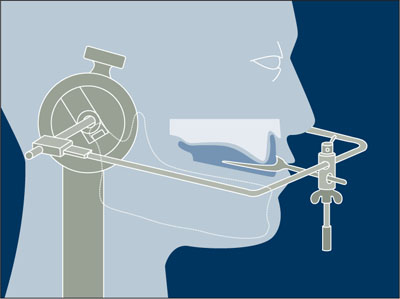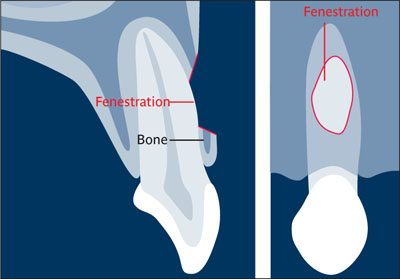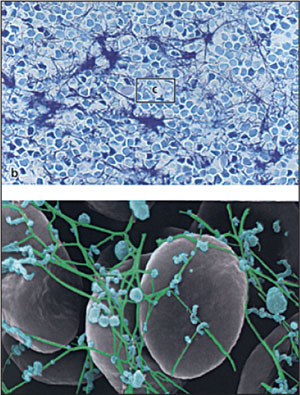F
Facebow Instrument used to record the positional relationship in the patient of the maxillary arch to the horizontal condylar axis of the mandible and to transfer this record to an articulating device that can simulate mandibular movements. A refinement to the conventional face-bow is known as a kinematic (hinge-bow) type, which has adjustable condylar rods, allowing the accurate location of the horizontal axis of mandibular rotation.1,2

Facebow transfer to articulator.
(Redrawn from Sharry3 with permission.)
Facial Surface of incisors or canines and associated oral structures adjacent to the lips or cheeks.4
Facial moulage Impression of facial soft tissues and bony contours to obtain a working cast for the fabrication of an extraoral prosthesis.5
Facial profile Sagittal outline form of the face seen in the median plane.4
Facial prosthesis Maxillofacial artificial replacement for a part of the face missing because of surgical, traumatic, or congenital etiology. See also: Craniofacial prosthesis; Maxillofacial prosthetics.4
Facial symmetry Mutually balanced relationship of facial parts relative to size, arrangement, or measurements.6
Facing Tooth-colored material used to restore the visible surface of a prepared tooth or prosthetic replacement.4 See also: Veneer.
Fatigue Property of metals that become embrittled and prone to fracture; caused by grain growth through repeated loading or flexure.
FDBA Abbreviation for Freeze-dried bone allograft.
FEA Abbreviation for Finite element analysis.
Fenestration Buccal or lingual window defect of either bone or soft tissue, occurring over a tooth root, implant, or alveolar ridge. See also: Dehiscence.

Fenestration.
Festoon Contour of the soft tissues covering the roots of the teeth that tends to follow the cervical lines. Specifically in prosthodontics, a carving in the base material of a denture that simulates the contours of the natural tissues being replaced by the denture.
FGF Abbreviation for Fibroblast growth factor.
FHA Abbreviation for Fluorohydroxyapatite.
Fibrin clot Clump that results from coagulation of the blood after a sequential process by which the multiple coagulation factors of the blood interact in the coagulation cascade. Essentially composed of fibrin, this insoluble protein is formed from fibrinogen by the proteolytic action of thrombin. Called also blood clot.

Fibrin clot (scanning electron micrographs; high magnification).
(Reprinted from Lang et al7 with permission.)
Fibrinolysis (pl: fibrinolyses) Enzymatic process of dissolution of fibrin. Plasmin, the main enzyme involved, degradates the fibrin mesh, leading to the production of circulating fragments that are cleared by other proteinases or organs.
Fibrin-rich matrix Provisional matrix provided by the fibrin clot and fibronectin at the first phase of wound healing. It helps monocytes, fibroblasts, and epidermal cells migrate into the healing area.8
Fibroblast Cell derived from mesoderm, predominant in the connective tissue. This flat elongated cell, with cytoplasmic processes at each end and a large, oval, vesicular nucleus, secretes fibrillar procollagen, fibronectin, and collagenase and is involved in extracellular matrix production and remodeling.
Fibroblast growth factor (FGF) Family of growth factors with mitogenic properties for fibroblasts and mesoderm-derived cell types. They have important roles in angiogenesis, neurogenesis, wound healing, and tumor growth. In humans, more than 20 proteins have been identified as members of the FGF family. FGF-2, or basic FGF (bFGF), has been the most studied member of the FGF family for therapeutic purposes in regenerative treatments, notably soft tissue healing.
Fibromatosis (pl: fibromatoses) Group of tumor-like lesions that have an infiltrative nature and can be locally aggressive, making them difficult to remove completely. They can recur following surgery but do not metastasize to other parts of the body. Fibromatoses have also been known to undergo spontaneous regression and completely disappear.
Fibronectin Adhesive glycoprotein with a high molecular weight (450 kd), composed of two disulfide-linked polypeptides. Functional domains of the molecule have an affinity for cells and the extracellular matrix components. It is found on cell surfaces, in connective tissues, in the blood, and in other body fluids. Fibronectins are important in connective tissue, where they cross-link to collagen, promote cellular adhesion and/or migration, and are involved in aggregation of platelets.
Stay updated, free dental videos. Join our Telegram channel

VIDEdental - Online dental courses


